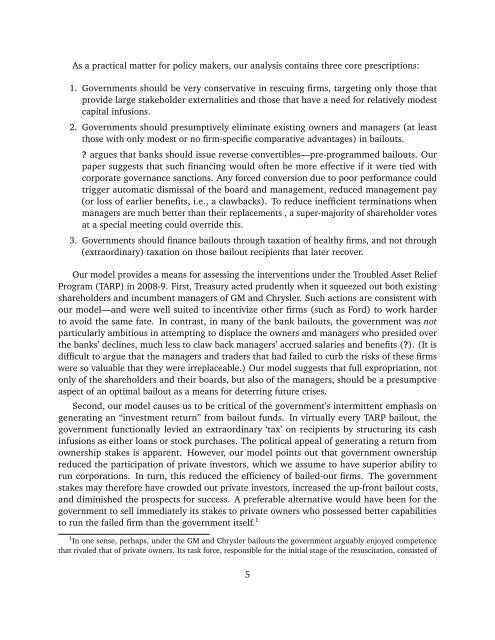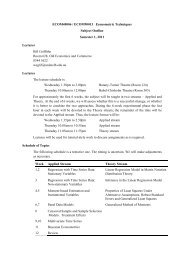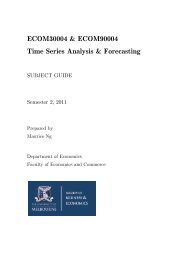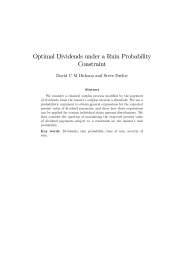A Model of Optimal Corporate Bailouts - Faculty of Business and ...
A Model of Optimal Corporate Bailouts - Faculty of Business and ...
A Model of Optimal Corporate Bailouts - Faculty of Business and ...
You also want an ePaper? Increase the reach of your titles
YUMPU automatically turns print PDFs into web optimized ePapers that Google loves.
As a practical matter for policy makers, our analysis contains three core prescriptions:1. Governments should be very conservative in rescuing firms, targeting only those thatprovide large stakeholder externalities <strong>and</strong> those that have a need for relatively modestcapital infusions.2. Governments should presumptively eliminate existing owners <strong>and</strong> managers (at leastthose with only modest or no firm-specific comparative advantages) in bailouts.? argues that banks should issue reverse convertibles—pre-programmed bailouts. Ourpaper suggests that such financing would <strong>of</strong>ten be more effective if it were tied withcorporate governance sanctions. Any forced conversion due to poor performance couldtrigger automatic dismissal <strong>of</strong> the board <strong>and</strong> management, reduced management pay(or loss <strong>of</strong> earlier benefits, i.e., a clawbacks). To reduce inefficient terminations whenmanagers are much better than their replacements , a super-majority <strong>of</strong> shareholder votesat a special meeting could override this.3. Governments should finance bailouts through taxation <strong>of</strong> healthy firms, <strong>and</strong> not through(extraordinary) taxation on those bailout recipients that later recover.Our model provides a means for assessing the interventions under the Troubled Asset ReliefProgram (TARP) in 2008-9. First, Treasury acted prudently when it squeezed out both existingshareholders <strong>and</strong> incumbent managers <strong>of</strong> GM <strong>and</strong> Chrysler. Such actions are consistent withour model—<strong>and</strong> were well suited to incentivize other firms (such as Ford) to work harderto avoid the same fate. In contrast, in many <strong>of</strong> the bank bailouts, the government was notparticularly ambitious in attempting to displace the owners <strong>and</strong> managers who presided overthe banks’ declines, much less to claw back managers’ accrued salaries <strong>and</strong> benefits (?). (It isdifficult to argue that the managers <strong>and</strong> traders that had failed to curb the risks <strong>of</strong> these firmswere so valuable that they were irreplaceable.) Our model suggests that full expropriation, notonly <strong>of</strong> the shareholders <strong>and</strong> their boards, but also <strong>of</strong> the managers, should be a presumptiveaspect <strong>of</strong> an optimal bailout as a means for deterring future crises.Second, our model causes us to be critical <strong>of</strong> the government’s intermittent emphasis ongenerating an “investment return” from bailout funds. In virtually every TARP bailout, thegovernment functionally levied an extraordinary ‘tax’ on recipients by structuring its cashinfusions as either loans or stock purchases. The political appeal <strong>of</strong> generating a return fromownership stakes is apparent. However, our model points out that government ownershipreduced the participation <strong>of</strong> private investors, which we assume to have superior ability torun corporations. In turn, this reduced the efficiency <strong>of</strong> bailed-out firms. The governmentstakes may therefore have crowded out private investors, increased the up-front bailout costs,<strong>and</strong> diminished the prospects for success. A preferable alternative would have been for thegovernment to sell immediately its stakes to private owners who possessed better capabilitiesto run the failed firm than the government itself. 11 In one sense, perhaps, under the GM <strong>and</strong> Chrysler bailouts the government arguably enjoyed competencethat rivaled that <strong>of</strong> private owners. Its task force, responsible for the initial stage <strong>of</strong> the resuscitation, consisted <strong>of</strong>5
















